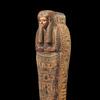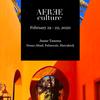Michelangelo's Madonna of the Stairs and Battle of the Centaurs restored thanks to Friends of Florence
- FLORENCE, Italy
- /
- May 03, 2022
MADONNA OF THE STAIRS AND BATTLE OF THE CENTAURS BY MICHELANGELO BUONARROTI HAVE BEEN RESTORED THROUGH THE GENEROSITY OF THE FRIENDS OF FLORENCE
Florence, Italy… The restoration of two early sculptures Michelangelo Buonarroti created when he was training in the Garden of San Marco in Florence—Madonna of the Stairs (1490) and Battle of the Centaurs (1491-1492)—was completed in March and the works have returned to public view. The project, approved by the Casa Buonarroti Foundation, was made possible thanks to a gift from Friends of Florence. The gift also enabled the refurbishment of the “Room of Marbles” where both works are displayed in Casa Buonarroti, a museum devoted to the Renaissance master that was once his home.
The restoration of the two bas-reliefs were presented at the fifth edition of the Friends of Florence Award Grant at the Salone dell’Arte e del Restauro in 2020. Daniela Manna and Marina Vincenti restored the works under the direction of Casa Buonarroti and supervision of Soprintendenza Archeologia Belle Arti e Paesaggio per la Città Metropolitana di Firenze e le Province di Pistoia e Prato.
Simonetta Brandolini d’Adda, president of the Friends of Florence, said, “We are extremely grateful to Patricia and Marshall Geller, who supported the refurbishment of the room and restoration of Battle of the Centaurs, and to the Maher family for their contribution to the Madonna of the Stairs project. We are delighted to have worked in partnership with Cristina Acidini, president of the Casa Buonarroti Foundation, and Alessandro Cecchi, the museum’s director. Thanks also to Jennifer Celani, area official of the Soprintendenza ABAP di Firenze, and restorers Daniela Manna and Marina Vincenti who worked in perfect harmony giving us not only the opportunity to preserve these masterpieces, but also to learn much more about them.”
Restoration and Refurbishment
The meticulous restoration process provided an opportunity for an in-depth study and scholarly assessment of the two works. A non-invasive diagnostic campaign was followed by the application of cleaning procedures. Layers of atmospheric deposits and residues that dulled the surfaces were removed. The process revealed the artist’s exceptional skill in creating powerful chromatic and shading effects in high relief and salient features that would be visible in his more mature works.
Once the works were reinstalled, it was clear that the existing setting, the “Room of Marbles” with its light-colored interior, did not do them justice. Rather than enhancing the patina and intricate carvings, the surroundings washed them out. New metal supports and an LED lighting system now accentuate the works and make it possible to see all the exquisite details as the artist intended.
Madonna of the Stairs and Battle of the Centaurs
Michelangelo carved both reliefs during his apprenticeship in the Garden of San Marco, where
artists and intellectuals of Lorenzo the Magnificent’s circle would gather. He worked under the guidance of Bertoldo di Giovanni, Donatello’s last pupil and assistant, who died in 1491.
The artist was just fifteen years old when he created the Madonna of the Stairs. Although the technique for bas-relief carving was essentially developed by Donatello, the depiction of the staircase was Michelangelo’s innovation, producing the illusion of greater depth. The composition is dominated by the Virgin Mary with her Son at her breast. Michelangelo repeated the pose in his later works such as the Medici Madonna, the sculptural group in the New Sacristy, and the drawing in Casa Buonarroti known as the “Cartonetto.”
The carving was still with the family after Michelangelo’s death in 1564, but his nephew and heir, Leonardo, reluctantly gave it to Duke Cosimo I de’ Medici, along with unfinished statues that had remained in Florence such as the Spirit of Victory in Palazzo Vecchio and the four Slaves now in the Galleria dell’ Accademia. As Vasari wrote in 1568, the duke treasured the carving and it was part of the Medici collections until 1616 when grand duke Cosimo II generously gave it to the artist’s grand-nephew, Michelangelo Buonarroti the Younger, who wanted to honor the master in the gallery of Casa Buonarroti.
Michelangelo carved the Battle of the Centaurs between 1491 and 1492. The subject was described by art historians Ascanio Condivi in 1553 as “The Abduction of Deianira” and Vasari in 1568 as “The Battle of Hercules with the Centaurs.” Agnolo Poliziano, the humanist and member of Lorenzo of the Magnificent’s circle, suggested the subject and Lorenzo commissioned it. However, the work was still unfinished when the great patron died on April 8, 1492.
The artist either based the piece on the passage in Ovid’s Metamorphoses (XII, 210-576) describing the battle between the Lapithae and the Centaurs at the wedding of Pirithous and Hippodamia, or on a myth related to the labors of Hercules in which the hero saved his betrothed Deianira from having to marry the centaur Eurytion, who was killed in a furious battle with the Centaurs. With the tight tangles of limbs and bodies, the relief recalls classical sarcophagi. The fact that it is unfinished offers a taste of the young artist’s skill carving marble with varying degrees of finishing: from the almost full figures, including the three-quarter view of the hero that anticipates the iconic David, to the delicate reliefs of the fighters in the background with his extraordinary control depicting the interlocking bodies.
The expressions and emotions of even the barely defined figures are striking: the anger of the fighters, the violence of the abductors, the pain of the wounded. The marchese Federico Gonzaga was interested in purchasing it in 1527, but Michelangelo did not part with it before he definitively moved to Rome in 1534. It stayed with the Buonarroti family and from 1614 to 1874, it enjoyed pride of place under the Epifania by Condivi in the gallery Michelangelo Buonarroti the Younger established to celebrate his famous ancestor and the family’s benefactor.
Cristina Acidini, President of the Casa Buonarroti Foundation, said, “Being able to see marble sculptures up close is always an experience that thrills, astonishes, and increases our appreciation of the artist’s genius. The restoration and scholarly reassessments of these works inform our ongoing presentation and safeguarding of the collection. We are deeply grateful for the generosity of the Friends of Florence foundation and its president Simonetta Brandolini d'Adda whom I wish to thank on behalf of Casa Buonarroti.”
Simonetta Brandolini d’Adda added, “For us, supporting the restoration of these two seminal works means continuing to preserve the artistic heritage of this extraordinary artist who left us some of the greatest masterpieces in the Western canon. After the restoration and (ongoing) maintenance of the David, the Slaves, the River God, and most recently the Bandini Pietà, our foundation is delighted to continue the essential task of protecting Florence’s cultural heritage for generations to come.”
About Friends of Florence
Friends of Florence is a non-profit foundation supported by individuals from around the world who are dedicated to preserving and enhancing the rich cultural heritage of Florence and Tuscany and conserving irreplaceable artistic and cultural treasures. Friends of Florence identifies significant projects spanning centuries in need of restoration, secures funding, and works in collaboration with local authorities to complete projects.
Since its founding in 1998, the Foundation has raised and donated $10 million for conservation projects in the region. Friends of Florence works directly with Florence’s famed conservation laboratories to ensure restoration is done at the highest level, has the approval of the City of Florence and the Italian Ministry of Art, and is completed on time and on budget.
Through its work, Friends of Florence creates opportunities for the study and appreciation of paintings, sculptures, architectural elements, places of worship, and collections at the Uffizi Gallery, the Accademia, the Baptistry, the Piazza della Signoria, the Museum of San Marco, and dozens of other museums, churches, and public sites.
A model of high-impact, low-overhead philanthropy, Friends of Florence is the primary source of funding for the city’s conservators, a respected partner with museums and cultural authorities in Italy and the U.S., and a publisher/producer of publications, multimedia offerings, seminars, lectures, and cultural travel opportunities. For more information, visit its newly designed website at www.friendsofflorence.org.
For more information:
Friends of Florence
ITALY
Elisa Bonini
elisaboniniitaly@friendsofflorence.org
mob. +39 333 6729563
USA
Lisbeth Mark, Bow Bridge Communications
tel. +1 917 968 5567
Image Captions (Top to Bottom, L to R):
Michelangelo Buonarroti (1475-1564). Madonna of the Stairs, 1490. Marble, 55.5 x 40 cm. After restoration completed by Friends of Florence in 2022. Photo: Antonio Quattrone and Ottaviano Caruso
Michelangelo Buonarroti (1475-1564). Battle of the Centaurs, 1491-1492. Marble, 80.5 x 88 cm. After restoration completed by Friends of Florence in 2022. Photo: Antonio Quattrone and Ottaviano Caruso
Michelangelo Buonarroti (1475-1564). Madonna of the Stairs, 1490. Marble, 55.5 x 40 cm. Details during restoration by Friends of Florence, 2021-22. Photo: Antonio Quattrone and Ottaviano Caruso
Michelangelo Buonarroti (1475-1564). Battle of the Centaurs, 1491-1492. Marble, 80.5 x 88 cm. Details during restoration by Friends of Florence, 2021-22. Photo: Antonio Quattrone and Ottaviano Caruso
“Room of Marbles” in Casa Buonarroti, Florence, Italy. After refurbishment completed by Friends of Florence, 2022. Photo: Claudio Giusti
Contact:
Libby MarkBow Bridge Communications
1 917 968 5567
info@bow-bridge.com








_Infinity_by_Santiago_Medina_PhotoCr100x100_c.jpg)






100x100_c.jpg)
